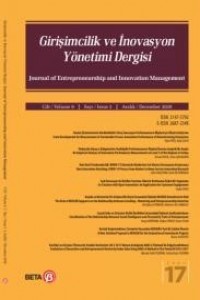Involvement of Stakeholders in the R&D and Innovation Process: an Analysis of Nigeria’s Innovation System
Involvement of Stakeholders in the R&D and Innovation Process: an Analysis of Nigeria’s Innovation System
Research Institutes, National Innovation System, Nigeria, Entrepreneurs, Financial Institution.,
___
- Adeboye T. (1997). “Science and Technology Policy: Sub-Saharan African Coun- tries in the context of Global Trends, IEA, Accra, Ghana.
- Adeboye T. (2000). “Science and Technology for Africa Development”. United Nations Economic Commission for Africa; Food and Sustainable Division. http:// www. un.org/depts/eca/divis/fssd/, pp. 1-42.
- AIO (Afrcan Innovation Outlook) (2010). Undertaken by the AU/NEPAD in the ASTII project. Available at: http://www.nepad.org/system/files/June2011_NEPAD_ AIO_2010_English.pdf (accessed 23 March 2014).
- Cervantes M. (1999). “Public/Private Partnership in Science and Technology: An Overview”. STI Review, No.23. OECD, p. 4.
- European Commission (2004). “Management of Intellectual Property in Pub- licly-Funded Research Organizations: Towards European Guidelines. Expert Group Report, EC. http://europa.eu.int/com/research/era/ipr.en.html
- Federal Government of Nigeria (1981). “National Policy on Education (Revised) Lagos. NERC Press.
- Freeman C. (1987). “Technology Policy and Economic Performance: Lessons from Japan. Printer Publishers.
- Ilori M.O. (2006). “From Science to Technology and Innovation Management”. Inaugural Lecture Series, 191. Obafemi Awolowo University, Ile-Ife, Nigeria. p. 9-10.
- InfoDev (2006). Scaling up Innovation and Entrepreneurship in Developing Countries: The Role of Private Sector Finance. InfoDev, pp. 1-29.
- Jinma C., Gitta C., Disenso A. and Bince A. (2005). “Forging New Technology Alliances”. Cooperation South. pp. 59-71.
- Kim L. (1999). “Management of Technology in Developing Countries: Lessons for Africa. A paper presented under the distinguished scholar program of the Eco- nomic Commission of Africa, Addis Ababa, Ethiopia, 21st -26th June.
- Kwanjai N.M. (2000). “Applying General Systems Theory to put together NIS Jigsaw-Puzzle Pieces: A Profile of the Thai National Innovation System”. Paper pre- sented at INTECH-CERES WP.3 Conference. Maastriht, 17 May. p13.
- Lalkaka (1999). “New Strategies, Skills and Structures for Technological Innova- tions”. Paper presented at XVI IASP World Conference on Technology Parks. Istan- bul. September, p. 8.
- Lall S. (1992). Technical Capabilities and Industrialization. World Development, 20(2), 165-186.
- Lall S. (1996). Learning from the Asian Tigers. Studies in Technology and Indus- trial Policy, London: MacMillan.
- Lundvall B.A. (1992). “National System of Innovation”. Printer, London.
- Nakagawa K. (1999). Japanese Entrepreneurship: Can the Silicon Valley Model be Applied to Japan? Silicon alley Networks Project Seminar Series, Asia/Pacific Re- search Centre, pp. 3-15.
- Oduola I.A., Akarakiri J.B. and Ilori M.O. (2005). Organization, Governance and Networking Practices in Public R&D Organizations in Nigeria. Quarterly Journal of Administration, xxxii, 38-65.
- OECD (1999). “National Innovation Systems. Paris.
- OECD (2002). Frascati Manual: Proposed Standard Practice for Surveys on Re- search and Experimental Development, 6th edn.
- Oke J.S. (2005). “An Evolution of the Nigerian Innovation System and Techno- logical Capability Building in the Manufacturing Sector. Ph.D. Dissertation.
- Okebukola P. (2002). “The State of University Education in Nigeria. National Universities Commission, Abuja, pp. 42.
- Oyelaran-Oyeyinka B. (2002). “Manufacturing Response in Systems of Inno- vation: Evidence from Brewing Firms in Nigeria.” UNU/INTEC, Discussion Paper No.2002-3.
- Oyelaran-Oyeyinka B. and Barclay L.A. (2003). “Systems of Innovation and Hu- man Capital in African Development”. UNU/INTECH, Discussion Paper No. 2003-2.
- Oyewale A.A. (2003). Evaluation of the Interactions amonf the Key Elements of Science and Technology Innovation System in Nigeria. Unpublished Ph.D. Thesis, Obafemi Awolowo University, Ile-Ife, Nieria.
- Patel P. and Pavitt K. (1994). “The Nature and Economic Importance of National Innovation Systems”. STI Review. No.14 OECD. Paris
- Pavitt, K. (1991). “What makes basic research economically useful?” Research Policy, 20:109–119.
- Porter M. (1990). “The Competitive Advantage of Nations”. Harvard Business Review. 68(2), 73-94.
- Plonski G. (2000). “S&T Innovation and Cooperation in Latin America. Coopera- tion South, 1, 99-107.
- Schumpeter, J. A. (1911). Theorie der wirtschaftlichen Entwicklung. Eine Unter- suchung ueber Unternehmergewinn, Kapital, Kredit, Zins und den Konjunkturzyk- lus, Berlin: Duncker und Humblot; translated by Redvers Opie, 1934 & 1963, The Theory of Economic Development: an Inquiry into Profits, capital, credit, Interest and the Business Cycle, Oxford: Oxford university Press.
- Schumpeter, J. A. (1942). Capitalism, Socialism and Democracy, New York: Harper and Row.
- Senker J. and Senker P. (1997). Relationship for Universities: A Case Study of the UK Teaching Company Scheme. Science and Public Policy, 24(3), 173-182.
- Stanton W.J., Etzel M.J. and Walker B.J. (1994). Fundamentals of Marketing, 10th Edition, New York: McGraw Hill, Incorporation.
- Wong, P.K., Ping Ho, Y. and Autio, E. (2005). Entrepreneurship, Innovation and Economic Growth:Evidence from GEM data. Small Business Economics. 24: 335–350
- World Bank (2002). “Results of the Nigerian Firm Survey”. www.worldbank.org/ rped/ documents/rped118.pdf.
- http://ec.europa.eu/invest-in-research/pdf/download-en-/final-crest-report- march2006.pdf (browsed: September 2013)
- ISSN: 2147-5792
- Başlangıç: 2012
- Yayıncı: Beta Basım Yayım Dağıtım A.Ş.
A Short Review on SMEs, Innovation and Financial Markets
Selçuk KARAATA, Fatma HACIOĞLU
Yenilikçilik mi? Tüketim mi?: Yenilikçi Tüketime Eleştirel Bir Yaklaşım ve Nitel Bir Analiz
Özge GÖKBULUT ÖZDEMİR, Deniz ÖZER
Burak ÇAPRAZ, Nazlı Ayşe AYYILDIZ ÜNNÜ, Derya KELGOKMEN İLİC, Murat KOCAMAZ, Ural Gökay ÇİÇEKLİ, Burcu ARACIOĞLU, Aydın KOÇAK, Jülide KESKEN, Haluk SOYUER
Bolanle OYEDOYIN, Mathew Olugbenga ILORI, Timothy OYEBISI, Billy Agbebola OLUWALE, Oluseye Oladayo JEGEDE
